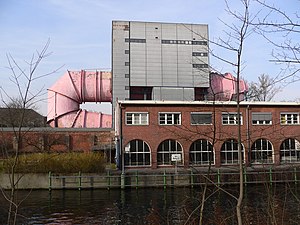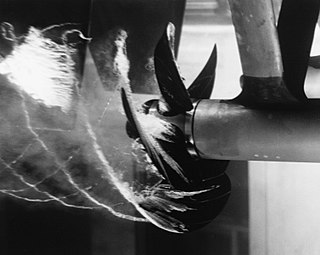
Cavitation in fluid mechanics and engineering normally refers to the phenomenon in which the static pressure of a liquid reduces to below the liquid's vapour pressure, leading to the formation of small vapor-filled cavities in the liquid. When subjected to higher pressure, these cavities, called "bubbles" or "voids", collapse and can generate shock waves that may damage machinery. These shock waves are strong when they are very close to the imploded bubble, but rapidly weaken as they propagate away from the implosion. Cavitation is a significant cause of wear in some engineering contexts. Collapsing voids that implode near to a metal surface cause cyclic stress through repeated implosion. This results in surface fatigue of the metal, causing a type of wear also called "cavitation". The most common examples of this kind of wear are to pump impellers, and bends where a sudden change in the direction of liquid occurs. Cavitation is usually divided into two classes of behavior: inertial cavitation and non-inertial cavitation.

A propeller is a device with a rotating hub and radiating blades that are set at a pitch to form a helical spiral which, when rotated, exerts linear thrust upon a working fluid such as water or air. Propellers are used to pump fluid through a pipe or duct, or to create thrust to propel a boat through water or an aircraft through air. The blades are shaped so that their rotational motion through the fluid causes a pressure difference between the two surfaces of the blade by Bernoulli's principle which exerts force on the fluid. Most marine propellers are screw propellers with helical blades rotating on a propeller shaft with an approximately horizontal axis.

A turbopump is a propellant pump with two main components: a rotodynamic pump and a driving gas turbine, usually both mounted on the same shaft, or sometimes geared together. They were initially developed in Germany in the early 1940s. The purpose of a turbopump is to produce a high-pressure fluid for feeding a combustion chamber or other use. While other use cases exist, they are most commonly found in liquid rocket engines.

A water turbine is a rotary machine that converts kinetic energy and potential energy of water into mechanical work.

Wind tunnels are machines where an object is held stationary inside a tube, and air is blown around it to study the interaction between the object and the moving air. They are used to test the aerodynamic effects of aircraft, rockets, cars, and buildings. Different wind tunnels range in size from less than a foot across, to over 100 feet (30 m), and can have air that moves at speeds from a light breeze to hypersonic velocities.

Supercavitation is the use of a cavitation bubble to reduce skin friction drag on a submerged object and enable high speeds. Applications include torpedoes and propellers, but in theory, the technique could be extended to an entire underwater vessel.

A magnetohydrodynamic drive or MHD accelerator is a method for propelling vehicles using only electric and magnetic fields with no moving parts, accelerating an electrically conductive propellant with magnetohydrodynamics. The fluid is directed to the rear and as a reaction, the vehicle accelerates forward.
The von Karman Institute for Fluid Dynamics (VKI) is a non-profit educational and scientific organization which specializes in three specific fields: aeronautics and aerospace, environment and applied fluid dynamics, turbomachinery and propulsion. Founded in 1956, it is located in Sint-Genesius-Rode, Belgium.

A ship model basin is a basin or tank used to carry out hydrodynamic tests with ship models, for the purpose of designing a new ship, or refining the design of a ship to improve the ship's performance at sea. It can also refer to the organization that owns and operates such a facility.

National Taiwan Ocean University is a national university in Zhongzheng District, Keelung, Taiwan. NTOU is a member of University System of Taipei.

An impeller, or impellor, is a driven rotor used to increase the pressure and flow of a fluid. It is the opposite of a turbine, which extracts energy from, and reduces the pressure of, a flowing fluid.

The Carderock Division of the Naval Surface Warfare Center is one of eight Naval Sea Systems Command (NAVSEA) Surface Warfare Centers. The headquarters, located in Carderock, Maryland, includes the historic David Taylor Model Basin. The division includes remote sites across the United States concentrating on engineering, testing and modelling ship and ship's systems for the Navy. It has about 3,200 scientists, engineers, and support personnel working in more than 40 disciplines from fundamental science to applied and in-service engineering.

Marine engineering is the engineering of boats, ships, submarines, and any other marine vessel. Here it is also taken to include the engineering of other ocean systems and structures – referred to in certain academic and professional circles as "ocean engineering".
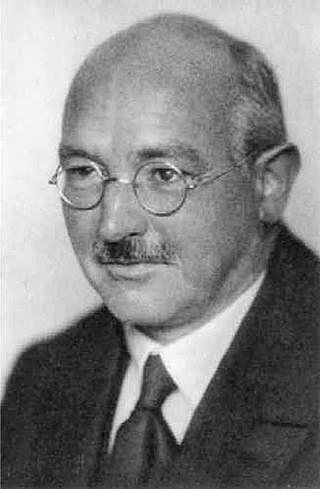
Albert Betz was a German physicist and a pioneer of wind turbine technology.
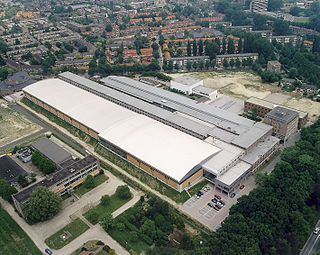
MARIN, the Maritime Research Institute Netherlands, is the leading institute in the world for hydrodynamic research and maritime technology. The services incorporate a unique combination of simulation, model testing, full-scale measurements and training programmes. MARIN provides services to the shipbuilding and offshore industry and governments. Customers include commercial ship builders, fleet owners, naval architects, classification societies, oil and LNG companies and navies all over the world.

The Emerson Cavitation Tunnel is a propeller testing facility that is part of the School of Engineering at Newcastle University.
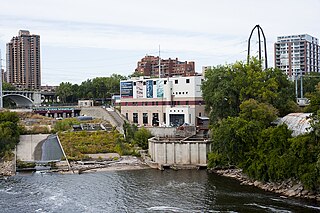
The Saint Anthony Falls Laboratory, or SAFL, is a research laboratory situated on Hennepin Island in the Mississippi River in Minneapolis, Minnesota, United States. Its primary research is in "Engineering, Environmental, Biological, and Geophysical Fluid Mechanics". It is affiliated with the University of Minnesota's College of Science and Engineering. Research is conducted by graduate students and faculty alike using the 16,000 square feet of research space and 24 different specialized facilities.

In aeronautics and marine hydrodynamics, the advance ratio is the ratio of the freestream fluid speed to the propeller, rotor, or cyclorotor tip speed. When a propeller-driven vehicle is moving at high speed relative to the fluid, or the propeller is rotating slowly, the advance ratio of its propeller(s) is a high number. When the vehicle is moving at low speed or the propeller is rotating at high speed, the advance ratio is a low number. The advance ratio is a useful non-dimensional quantity in helicopter and propeller theory, since propellers and rotors will experience the same angle of attack on every blade airfoil section at the same advance ratio regardless of actual forward speed. It is the inverse of the tip speed ratio used for wind turbines.

The Garfield Thomas Water Tunnel is one of the U.S. Navy's principal experimental hydrodynamic research facilities and is operated by the Penn State Applied Research Laboratory. The facility was completed and entered operation in 1949. The facility is named after Lieutenant W. Garfield Thomas Jr., a Penn State journalism graduate who was killed in World War II. For a long time, the Garfield Thomas Water Tunnel was the largest circulating water tunnel in the world. It has been declared a historic mechanical engineering landmark by the American Society of Mechanical Engineers.

Joseph Katz is an Israel-born American fluid dynamicist, known for his work on experimental fluid mechanics, cavitation phenomena and multiphase flow, turbulence, turbomachinery flows and oceanography flows, flow-induced vibrations and noise, and development of optical flow diagnostics techniques, including Particle Image Velocimetry (PIV) and Holographic Particle Image Velocimetry (HPIV). As of 2005, he is the William F. Ward Sr. Distinguished Professor at the Department of Mechanical Engineering of the Whiting School of Engineering at the Johns Hopkins University.
